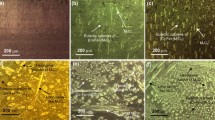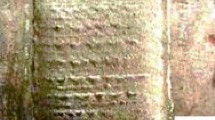Abstract
The wear of as-cast eutectic Fe30Ni20Mn35Al15, which consists of lamellar f.c.c. and B2 phases, was studied using pin-on-disk tribotests in four different environments: air, dry oxygen, dry argon, and a 4% hydrogen/nitrogen mixture. The counterface in all the tests was yttria-stabilized zirconia. Wear debris and wear tracks were examined in detail to investigate the surface effects during dry sliding and these were correlated with the wear properties. It was found that the wear rate was about 40% lower in tests performed under argon, compared to tests conducted in either air or oxygen. However, the wear rate was about 1000% higher when the tests were conducted in a hydrogen-containing environment. The near-surface regions of the pins were examined using transmission electron microscopy of cross-sectional specimens produced by focused ion beam milling. For tests in oxygen-containing environments, abrasive particles were produced by oxidation. These, protruded and peeled off from the matrix and mixed with the debris from the counterface, producing a combination of a two-body and three-body abrasive wear-controlled processes. In contrast, for tests under argon, plastic flow mechanisms dominated. The dramatic increase of wear in 4% hydrogen/nitrogen was due to hydrogen embrittlement, which meant that little plastic flow occurred, a feature consistent with the results of prior tensile tests.















Similar content being viewed by others
References
Liao Y (2009) Doctoral dissertation, Dartmouth College
Kim YS, Kim YH (1998) Mater Sci Eng A 258:319
Hawk JA, Alman DE (1997) Mater Sci Eng A 239–240:899
Guan XS, Iwasaki K, Kishi K, Yamamoto M, Tanaka R (2004) Mater Sci Eng A 366:127
Rao Bonda N, Rigney DA (1989) Proc MRS 133:585
Singh J, Alpas AT (1995) Wear 191–183:302
Kato H, Eyre TS, Ralph B (1994) Acta Metal Mater 42:1703
Kennedy FE, George M, Baker I, Johnson BJ, Chang N (1995) Proceedings of the international tribology conference, Yokohama, I, p. 337
Munroe PR, George M, Baker I, Kennedy FE (2002) Mater Sci Eng A 325:1
Kennedy FE, Voss DA (1979) A re-examination of the wear of leaded brass on hardened steel. Wear of Materials ASME, New York
Kennedy FE, Hauck KK, Grotelueschen LP (1986) In: Dowson D (ed) Mechanisms and surface distress. Butterworths, London, p 67
Lancaster JK (1990) Tribol Int 23:372
Liao Y, Meng F, Baker I (2011) Intermetallics 19:1533
Liu CT, Lee EH, Mckamey CG (1989) Scr Metall 23:875
Johnson BJ, Kennedy FE, Baker I (1996) Wear 192:241
Giannuzzi LA, Stevie FA (1999) Micron 30:197
Baker I, Sun Y, Kennedy FE, Munroe PR (2010) J Mater Sci 45:969. doi:10.1007/s10853-009-4027-1
Liao Y, Baker I (2008) Mater Charact 59:1546
Welsh NC (1965) Phil Trans R Soc Lond A 257:51
Moore MA (1971) Wear 17:51
Maupin HE, Wilson RD, Hawk JA (1993) Wear 162–164:432
Rigney DA (2000) Wear 245:1
Li J, Elmadagli M, Gertsman VY, Lo J, Alpas AT (2006) Mater Sci Eng A 421:317
Jones JW, Wert JJ (1975) Wear 32:363
Stolofl NS, Liu CT (1994) Intermetallics 2:75
Nathal MV (1995) Intermetallics 3:77
Bhushan B, Gupta BK (1991) Handbook of tribology. McGraw-Hill, New York, p 4.71
Hutchings IM (1992) Tribology, friction and wear of engineering materials. CRC Press, Boca Raton, p 14
Acknowledgements
This research was supported by National Science Foundation (NSF) Award DMR-0905229. Any opinions, findings, and conclusions or recommendations expressed in this material are those of the authors’ and do not necessarily reflect the views of NSF. We would like to acknowledge technical help from Dr. Charles Daghlian.
Author information
Authors and Affiliations
Corresponding author
Appendix: Calculation of contact area and contact temperature
Appendix: Calculation of contact area and contact temperature
Operating conditions:
Normal load w = 23 N | Sliding velocity V = 1 m s−1 |
Average friction coefficient (measured) μ = 0.15 | Pin radius r = 1.5 mm |
Material properties (*measured, data of zirconia is from [27])
Zirconia (material 1) | As-cast Fe30Ni20Mn35Al15 (material 2) | |
|---|---|---|
Η Hardness (GPa) | 12.7 | 3* |
Ε Modulus of elasticity (GPa) | 290 | 120* |
ρ Density (kg/m3) | 6100 | 7020* |
υ Poisson’s ratio | 0.24 | 0.33 |
Κ Thermal conductivity (W/m K) | 1.8 | 9.3* |
C Specific heat (J/kg K) | 630 |
Contact geometry (assuming Hertzian contact [28])
where \( \frac{1}{E } = \frac{{1 - \upsilon_{1}^{2} }}{{E_{1} }} + \frac{{1 - \upsilon_{2}^{2} }}{{E_{2} }} \) (E 1, E 2 are the moduli of elasticity for material 1 and material 2, respectively, while υ 1 and υ 2 are the Poisson’s ratio for material 1 and material 2, respectively)
Assume stationary pin (material 2) and moving flat Zirconia disk (material 1)
where the Peclet number \( P_{e1} = \frac{{Va\rho_{1} C_{1} }}{{2K_{1} }} = 70 \) (V is the sliding velocity of disk, while ρ 1, C 1, and K 1 is the density, specific heat and thermal conductivity of material 1, respectively), and \( P_{e2} = \frac{{V_{2} a\rho_{2} C_{2} }}{{2K_{2} }} = 0 \) (V 2 is the sliding velocity of pin, while ρ 2, C 2, and K 2 is the density, specific heat and thermal conductivity of material 2, respectively), \( p = \frac{w}{{\pi a^{2} }} \)
Given that the tests were conducted at room temperature (about 25 °C), the surface temperature at the center of the Hertzian contact area was 514 °C.
Rights and permissions
About this article
Cite this article
Meng, F., Baker, I. & Munroe, P.R. The effects of environment on the dry sliding wear of eutectic Fe30Ni20Mn35Al15 . J Mater Sci 47, 4827–4837 (2012). https://doi.org/10.1007/s10853-012-6341-2
Received:
Accepted:
Published:
Issue Date:
DOI: https://doi.org/10.1007/s10853-012-6341-2




